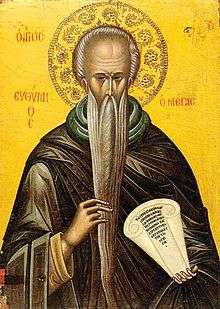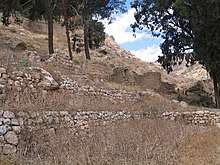Euthymius the Great
Saint Euthymius the Great (377 – 20 January 473) was an abbot in Palestine. He is venerated in both Roman Catholic and Eastern Orthodox Churches.
Saint Euthymius the Great | |
|---|---|
 | |
| Born | 377 Melitene, Lesser Armenia |
| Died | 20 January 473 (≈ aged 95) |
| Venerated in | Eastern Orthodoxy Roman Catholicism |
| Feast | January 20 |
Life

Euthymius was born in Melitene in Lesser Armenia, in a pious family of noble birth. According to Christian tradition, his parents, Paul and Dionysia, had prayed for a son at the church of Saint Polyeuctus in Melitene.[1] when the child was born, they named him "Euthymius", meaning "good cheer".[2]
Euthymius was educated by Bishop Otreius of Melitene, who afterwards ordained him and placed him in charge of all the monasteries in the Diocese of Melitene. At about thirty years of age he secretly set out on a pilgrimage to Jerusalem and remained for some time in a cave near a settlement of monks at a laura called Pharan, about six miles east of Jerusalem,[3][4] at Ein Fara in Wadi Kelt.[5]
In 411, Euthymius withdrew into the wilderness with a fellow-hermit, Saint Theoctistus (see below), living in a rough cavern on the banks of a torrent. When many disciples gathered around them, they turned the cavern into a church and built a monastery which was placed in the charge of St. Theoctistus.[4] Euthymius, despite retaining his solitary lifestyle, gave direction for the others.[3]
A miraculous cure which Euthymius was believed to have effected for Terebon, the son of the Saracen chief Aspebetus, spread the fame of the holy hermit far beyond the confines of Palestine. Aspebetus was afterwards ordained priest and became bishop over his tribe, in which capacity he attended the Council of Ephesus in 431.
When the report of this miracle had made the name of Euthymius famous throughout Palestine, and large crowds came to visit him in his solitude, he retreated with his disciple Domitian to the wilderness of Ruba, near the Dead Sea, living for some time on a remote mountain called Marda by the Byzantines - no other than the ancient Masada of Roman-era fame.[6] When large crowds followed him to this place also, he decided to return to the neighbourhood of the monastery of Theoctistus, where he took up his abode in a cavern. Every Sunday he came to the monastery to take part in the divine services. At length, because numerous disciples desired him as their spiritual guide, he founded in 420, on the right side of the road from Jerusalem to Jericho, a laura similar to that of Pharan, the Laura of Euthymius, later known as Khan al-Ahmar. The church connected with this laura was dedicated in 428 by Juvenal, the first Patriarch of Jerusalem.[7]
When the Fourth Œcumenical Synod (451) condemned the errors of Eutyches and Dioscorus, it was greatly due to the authority of Euthymius that most of the Eastern recluses accepted its decrees. The Empress Eudoxia was converted to Orthodoxy through his efforts.
The Church celebrates his feast on 20 January (2 February for those Orthodox Christians who still go by the Julian calendar[8]), the day of his death.
Theoctistus

Theoctistus, also spelled Theoktistos, aka the Venerable Theoctistus of Palestine, was an associate of Euthymius. He was an ascetic who lived in a nearby cell at the Pharan lavra.[9] About five years after Euthymius arrived, they went into the desert for Great Lent, and found in a wadi a large cave where they remained praying in solitude for some time. Eventually shepherds from Bethany discovered them, and people from the area began to visit seeking spiritual guidance and bringing food. The monks then built a church. When other monks came seeking instruction, Euthymius and Theoctistus built a lavra over the cave church. Theoctistus became hegumen of the monastery.[10]
Theoctistus died at an advanced age in 451 and is commemorated on 3 September.[11]
See also
- Anthony the Great (c. 251 – 356), monk who established Christian monasticism in the Egyptian desert
- Chariton the Confessor (end of 3rd century - ca. 350), founder of lavra-type monasticism in the Judaean desert
- Monastery of Martyrius
References
- Lives of all saints commemorated on January 9
- "Venerable Euthymius the Great", Orthodox church in America
- Attwater, Donald and Catherine Rachel John. The Penguin Dictionary of Saints. 3rd edition. New York: Penguin Books, 1993. ISBN 0-14-051312-4.
- Ott, Michael. "St. Euthymius." The Catholic Encyclopedia. Vol. 5. New York: Robert Appleton Company, 1909. 21 Jan. 2013
- Amnon Ramon, Around the Holy City, p. 67. The Jerusalem Institute for Israel Studies, 2000
- Euthymius and his monastery in the Judean Desert Archived 2016-03-06 at the Wayback Machine Hirschfeld, Yizhar. Israel Antiquities Authority
- Denys Pringle (1998). The Churches of the Crusader Kingdom of Jerusalem: L-Z (excluding Tyre). Cambridge University Press. p. 229.
- ru:Евфимий Великий
- "Theoctistus & Euthymius", Greek Orthodox Archdiocese of Australia
- "Venerable Theoctistus", Orthodox Church in America
- "Orthodox Calendar", Holy Trinity Russian Orthodox Church, East Baltimore
External links
- St Euthymius the Great Orthodox Icon and Synaxarion (January 20)
![]()